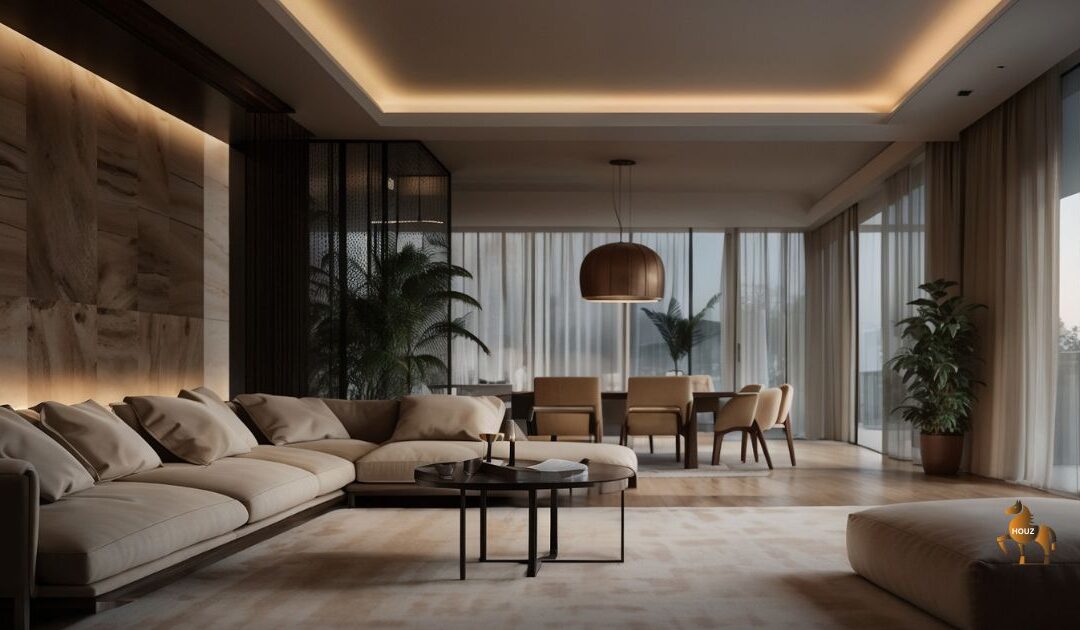Sustainable interior design means making spaces that are both lovely and gentle on our planet. It is about more than just looks; it considers the entire journey of materials and products. Our homes and workplaces have a big impact on the environment, from the energy they use to the stuff inside them. Embracing this design approach helps us connect our personal spaces with responsible living.
Choosing sustainable design brings many good things. It makes indoor air cleaner, which is better for your health. You can also save money on energy bills in the long run. Most importantly, it is very crucial to the preservation of our natural environment. Lets explore how we can design interior in ways that are benefit to us and the earth.
The Pillars of Sustainable Interior Design
Material Selection: The Foundation of Eco-Friendly Interiors
All the materials in our home have their story, including how they came to be in our homes and after use. The most important thing is selecting materials that have low environmental impact. That entails seeing how they are produced, how they reach you, and what then becomes of them on the day you do not need those things anymore. Reflective decisions produce eco-friendly interiors in the real sense. Sustainability doesn’t mean sacrificing character. Reclaimed wood feature walls or cushions dyed with natural pigments can be a stunning way to introduce warm, bold color into your home responsibly.
Reclaimed and Recycled Materials
Repurposing and giving old materials new life adds special charm to any space. Such wood as reclaimed one, for example, has rich textures and history, which make them suitable on feature walls or robust furniture. Recycled glasscan be transformed into gorgeous countertops or decorative tiles. Along with salvaged metals and other repurposed goods also bring character and rduce the amount of new resources. Think of an old barn door to be modified into a dining table.
Natural and Renewable Resources
Materials that grow back quickly or break down easily are excellent choices. Think about bamboo, which grows fast, or cork, harvested from tree bark without harming the tree. Organic cotton and wool give natural, soft fabrics and free from harsh chemicals. Another biodegradable product, and durable product is the natural linoleum which is composed of linseed oil. There is a vastly reduced carbon footprint on such materials.
Low-VOC and Non-Toxic Finishes
Air that we breathe indoor is often more polluted than outdoor air. VOCs, or Volatile Organic Compounds are found in a large number of paints, sealants and glues and they are dangerous chemicals. It is essential to have good indoor air quality by purchasing products that have low or no VOCs. Such non-toxic finishing safeguards the health of your family and maintains your house feeling very cool.
Energy Efficiency: Designing for Lower Consumption
Smart design choices can greatly lower the amount of energy a building needs. This means less power for heating, cooling, and lighting. Good design aims to use natural forces first, reducing your reliance on artificial systems. Making your home energy-efficient saves both money and resources over time.

Maximizing Natural Light
Using sunlight wisely can brighten your home and cut electricity bills. Placing windows correctly helps rooms fill with sunshine, warming them in winter and reducing the need for artificial light. Light-reflecting surfaces, like pale paint colours, also spread natural brightness around. This approach is part of passive solar design, using the sun’s energy to your benefit.
Smart Lighting Solutions
Upgrading your lighting can make a big difference to energy use. LED lights use much less power and have a very long lifespan in comparison with the traditional bulbs. Levels of light can be controlled by placing dimmers, which save power by not using full lights when not required. Motion sensors switch off the lights when they are not in use to avoid energy wastage. Look for lighting fixtures with energy-saving certification are recommended. A cornerstone of an eco-friendly home is reducing energy consumption. This is easily achieved by switching to LED bulbs and using smart lighting systems to create ambiance without waste
Insulation and Ventilation
For four season country proper insulation acts like a warm blanket over your house which maintained the heat in during winter and out during summer. This will lessen the level of exertion of your cooling and heating systems. Well working ventilation systems provide fresh air and duct stale air out thus preventing growth of moulds and ensuring healthier air. The combination helps to achieve a comfortable indoor climate with the reduced consumption of energy.
Water Conservation: Designing with Precious Resources in Mind
Every drop counts when it comes to water.There are ample opportunities to consume less water in the areas of interior design. You can reduce your water footprint by making the appropriate choices in the fixtures and systems. This is in the interest of adequate safeguarding of a very crucial natural resource for everyone.
Water-Efficient Fixtures
Replacing old fixtures for new, water-saving ones is an easy win. Low-flow faucets and showerheads deliver enough pressure with less water. Dual-flush toilets give you a choice for less water with liquid waste, saving litres every day. Look for products with WaterSense certification, which means they meet strict water efficiency standards. These small changes add up fast.
Rainwater Harvesting and Greywater Systems
More advanced sustainable homes might include rainwater harvesting. This collects rain from the roof for non-drinking uses, like flushing toilets or watering your garden. Greywater systems recycle water from sinks and showers. This used water, after simple treatment, can also serve for tasks that do not need fresh drinking water. Integrating these saves a lot of mains water.
Waste Reduction and Circularity: Closing the Loop
Minimising waste during decorating or renovating is a key part of sustainable interior design. It also means choosing items made to last and be recycled later. Thinking about a product’s full life cycle helps us move towards a circular economy. This way, fewer things end up in landfills, and more resources are reused.
Designing for Durability and Longevity
Investing in well-made, timeless pieces is a smart move. High-quality furniture and décor are built to stand the test of time, reducing the need for frequent replacements. When items last longer, fewer new resources are needed to make substitutes. Choose classics that you will love for years, rather than fleeting trends.
Responsible Disposal and Recycling
When it is time to part with old materials or furniture, do it wisely. Do not just throw things out. Research local recycling centres for items like metal, plastic, and glass. Many charities accept used furniture in good condition, giving it a new home. Proper disposal means less goes into landfills and more can be reused or recycled.
Upcycling and Customization
Upcycling old things and give it a new life. A vintage dresser may be transformed into a colorful custom vanity using an eco-friendly paint. Old wooden crates may become one of a kind shelving units. Modifying the available decor is not only saves money, but also it helps to create one of a kind piece. This has the benefit of cutting wastage and flaunts your creativity.
Bringing Sustainability into Your Home: Actionable Tips
For Homeowners and Renters
You do not need to make your home into a big project by making it more sustainable. Then there is little that you can do that will matter. You could begin today, right where you are.
Start Small: One Room at a Time
Feeling overwhelmed? Start with only one room, or half room. Perhaps, you could select a paint with low VOC to be used on the living room walls. Or, then again, you may be able to replace that old carpet with one that is woven of natural fibres. Every little step builds momentum and turns your home greener step by step.
Prioritize Secondhand and Vintage
Thrift stores, antique shops, and online marketplaces are treasure troves for unique finds. Buying pre-loved furniture and décor reduces waste and adds character to your home. You could get lucky and come across some hardwood dresser which just requires some love to look amazing again.. Give these items a second chance and enjoy their story.
Prioritise enduring quality over sheer quantity.
Acquiring fewer, superior items that last is often preferable. While initial expenses may be higher, these pieces typically endure better. They also reduce the need for frequent replacements. Consider a robust wooden table instead of a fragile, inexpensive one. Such an approach saves on resources in the long run. It enhances the beauty of your house as well.
For Design Professionals
Being a design professional, you are one who can influence greener space and guide clients towards a better future. Your choices have a wide impact.
Educate Your Clients
A lot of clients may be unaware of advantages of sustainable design. It is also important to tell how environmental friendly decisions are going to make them save money, make them healthier, and make the world a better place. Present to them the beautiful choices. Make them aware of more safe materials and intelligent energy consumption.
Seek Out Sustainable Certifications
Seek materials and construction method with proven endorsement. Using certified items demonstrates your commitment. It also builds client confidence
Collaborate with Eco-Conscious Suppliers
Build connections with responsible suppliers. Partner with companies sharing your green values. Seek those sourcing materials ethically. Prioritise manufacturers using clean production methods. Ensure they have clear supply chains. Collaboration will expand the market of eco-friendly goods and promote greenerness of your projects.
The Future of Interior Design: A Greener Tomorrow
Interior design is dynamic and always changing, its future appears much greener. Innovative solutions and technologies are also assisting us to come with yet friendlier grounds to the Earth. This vision looks to homes and offices which blend seamlessly with nature and use resources wisely. Discover the latest trends for interior design tips.
Biophilic Design and Its Role
It is biophilic design that takes nature inside. It implies the application of natural light, plants, water features and organic patterns in a facility. Such a strategy leads to a more contented and affinity-incorporated attitude to people and the natural environment. It perfectly fits into the agenda of sustainability because it tends to utilise natural materials and commonly diminishes the necessity of having an artificial material.
The Rise of the Circular Economy in Interiors
The circular economy keeps resources in use longer. In interiors, this means more take-back schemes. It involves designing furniture for easy disassembly. Parts can then be reused or recycled. This approach minimises waste. It maximises the use of existing materials.
Technological Innovations
Technology aids sustainable design practices. Lifecycle assessments track a product’s environmental footprint. Smart home systems manage energy consumption. They adjust lighting and heating automatically. These tools empower informed design decisions. They help create truly efficient spaces.
Conclusion
Sustainable interior design is about creating aesthetically pleasing and functional areas that respect our planet. This is being conscious of material choice. It also implies energy and water saving. Minimisation of wastes is crucial. All the decisions, including reclaimed wood and energy-saving lighting, contributes to a cleaner living environment and a healthier Earth..
You possess the ability to create positive change. Begin with a single room. Make one eco-conscious purchase. Prioritise durability. Embrace pre-owned items. Demand cleaner products. These actions support broader environmental goals. Creating eco-friendly spaces is not a fleeting trend. It is a responsible lifestyle choice. It blends attractive design with vital ecological care. To start your own sustainable project, contact our team for expert interior design services.


Recent Comments